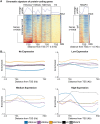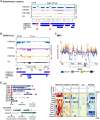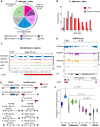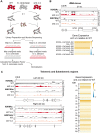Chromatin Profiling of the Repetitive and Nonrepetitive Genomes of the Human Fungal Pathogen Candida albicans
- PMID: 31337722
- PMCID: PMC6650553
- DOI: 10.1128/mBio.01376-19
Chromatin Profiling of the Repetitive and Nonrepetitive Genomes of the Human Fungal Pathogen Candida albicans
Abstract
Eukaryotic genomes are packaged into chromatin structures that play pivotal roles in regulating all DNA-associated processes. Histone posttranslational modifications modulate chromatin structure and function, leading to rapid regulation of gene expression and genome stability, key steps in environmental adaptation. Candida albicans, a prevalent fungal pathogen in humans, can rapidly adapt and thrive in diverse host niches. The contribution of chromatin to C. albicans biology is largely unexplored. Here, we generated the first comprehensive chromatin profile of histone modifications (histone H3 trimethylated on lysine 4 [H3K4me3], histone H3 acetylated on lysine 9 [H3K9Ac], acetylated lysine 16 on histone H4 [H4K16Ac], and γH2A) across the C. albicans genome and investigated its relationship to gene expression by harnessing genome-wide sequencing approaches. We demonstrated that gene-rich nonrepetitive regions are packaged into canonical euchromatin in association with histone modifications that mirror their transcriptional activity. In contrast, repetitive regions are assembled into distinct chromatin states; subtelomeric regions and the ribosomal DNA (rDNA) locus are assembled into heterochromatin, while major repeat sequences and transposons are packaged in chromatin that bears features of euchromatin and heterochromatin. Genome-wide mapping of γH2A, a marker of genome instability, identified potential recombination-prone genomic loci. Finally, we present the first quantitative chromatin profiling in C. albicans to delineate the role of the chromatin modifiers Sir2 and Set1 in controlling chromatin structure and gene expression. This report presents the first genome-wide chromatin profiling of histone modifications associated with the C. albicans genome. These epigenomic maps provide an invaluable resource to understand the contribution of chromatin to C. albicans biology and identify aspects of C. albicans chromatin organization that differ from that of other yeasts.IMPORTANCE The fungus Candida albicans is an opportunistic pathogen that normally lives on the human body without causing any harm. However, C. albicans is also a dangerous pathogen responsible for millions of infections annually. C. albicans is such a successful pathogen because it can adapt to and thrive in different environments. Chemical modifications of chromatin, the structure that packages DNA into cells, can allow environmental adaptation by regulating gene expression and genome organization. Surprisingly, the contribution of chromatin modification to C. albicans biology is still largely unknown. For the first time, we analyzed C. albicans chromatin modifications on a genome-wide basis. We demonstrate that specific chromatin states are associated with distinct regions of the C. albicans genome and identify the roles of the chromatin modifiers Sir2 and Set1 in shaping C. albicans chromatin and gene expression.
Keywords: Candida albicans; chromatin; epigenetics; euchromatin; genome instability; heterochromatin.
Copyright © 2019 Price et al.
Figures






Similar articles
-
Chromatin-Mediated Regulation of Genome Plasticity in Human Fungal Pathogens.Genes (Basel). 2019 Oct 28;10(11):855. doi: 10.3390/genes10110855. Genes (Basel). 2019. PMID: 31661931 Free PMC article. Review.
-
Candida albicans repetitive elements display epigenetic diversity and plasticity.Sci Rep. 2016 Mar 14;6:22989. doi: 10.1038/srep22989. Sci Rep. 2016. PMID: 26971880 Free PMC article.
-
The Chromatin of Candida albicans Pericentromeres Bears Features of Both Euchromatin and Heterochromatin.Front Microbiol. 2016 May 19;7:759. doi: 10.3389/fmicb.2016.00759. eCollection 2016. Front Microbiol. 2016. PMID: 27242771 Free PMC article.
-
Sir2 regulates stability of repetitive domains differentially in the human fungal pathogen Candida albicans.Nucleic Acids Res. 2016 Nov 2;44(19):9166-9179. doi: 10.1093/nar/gkw594. Epub 2016 Jul 1. Nucleic Acids Res. 2016. PMID: 27369382 Free PMC article.
-
To Repeat or Not to Repeat: Repetitive Sequences Regulate Genome Stability in Candida albicans.Genes (Basel). 2019 Oct 30;10(11):866. doi: 10.3390/genes10110866. Genes (Basel). 2019. PMID: 31671659 Free PMC article. Review.
Cited by
-
Superstructure Detection in Nucleosome Distribution Shows Common Pattern within a Chromosome and within the Genome.Life (Basel). 2022 Apr 6;12(4):541. doi: 10.3390/life12040541. Life (Basel). 2022. PMID: 35455033 Free PMC article.
-
Identification of an active RNAi pathway in Candida albicans.Proc Natl Acad Sci U S A. 2024 Apr 23;121(17):e2315926121. doi: 10.1073/pnas.2315926121. Epub 2024 Apr 16. Proc Natl Acad Sci U S A. 2024. PMID: 38625945 Free PMC article.
-
5-methylcytosine turnover: Mechanisms and therapeutic implications in cancer.Front Mol Biosci. 2022 Aug 17;9:976862. doi: 10.3389/fmolb.2022.976862. eCollection 2022. Front Mol Biosci. 2022. PMID: 36060265 Free PMC article. Review.
-
Chromatin profiling reveals heterogeneity in clinical isolates of the human pathogen Aspergillus fumigatus.PLoS Genet. 2022 Jan 10;18(1):e1010001. doi: 10.1371/journal.pgen.1010001. eCollection 2022 Jan. PLoS Genet. 2022. PMID: 35007279 Free PMC article.
-
Chromatin-Mediated Regulation of Genome Plasticity in Human Fungal Pathogens.Genes (Basel). 2019 Oct 28;10(11):855. doi: 10.3390/genes10110855. Genes (Basel). 2019. PMID: 31661931 Free PMC article. Review.
References
Publication types
MeSH terms
Substances
Grants and funding
LinkOut - more resources
Full Text Sources

